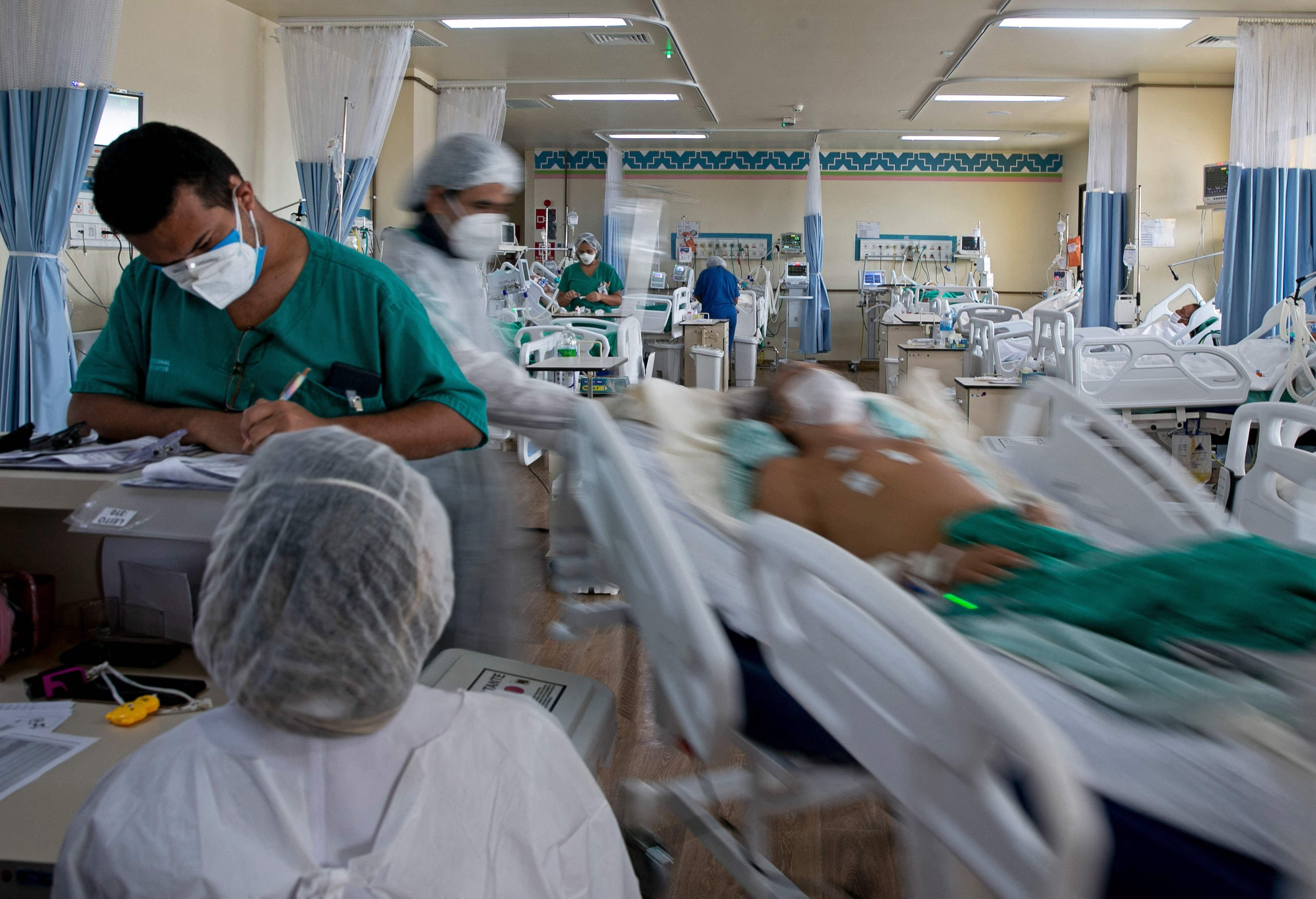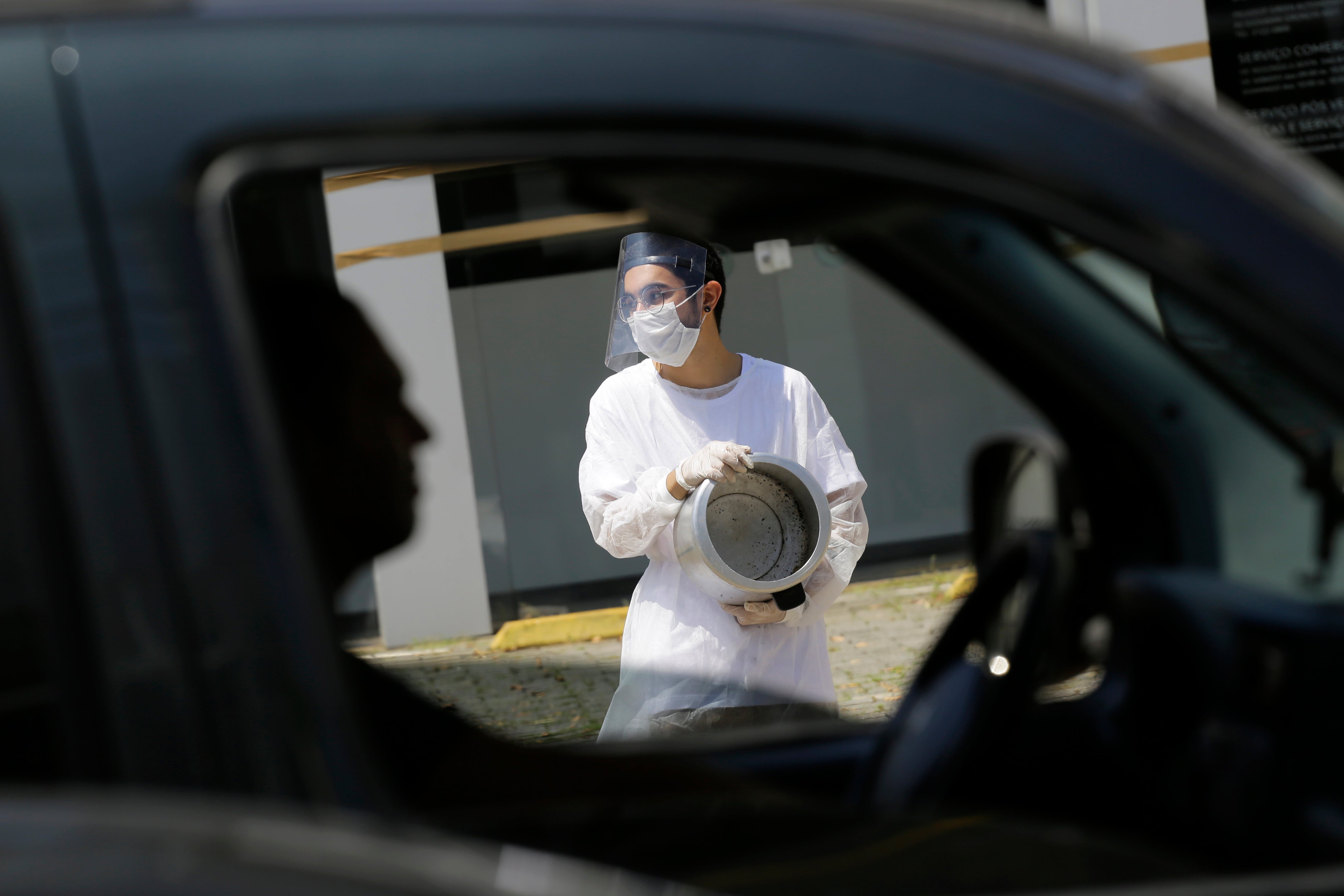Brazilian officials raise alarm over younger people getting virus in latest deadly surge
Brazil passed 300,000 total deaths earlier this week

Brazilian health officials are raising the alarm over new contagious variants which they believe are contributing to a catastrophic explosion of new infections, deaths and hospitalizations in younger people.
The country is grappling with its deadliest peak of the pandemic yet, as the South American nation continues to set a series of grim milestones of record daily deaths and new infections, pushing its hospitals to the brink of collapse.
The country, which is second behind the US in its death toll, surpassed 300,000 deaths on Wednesday, after a record 3,000 Brazilians died for the first time in a single day.
While mass vaccination remains a long way off, particularly for the young, several doctors from Covid-19 intensive care units across the country have reported an alarming trend: since the new year, their severe patients keep on getting younger and younger. And they don’t know why.
According to data gathered by local website Metropoles, (M)Data, the daily average of deaths under the age of 39 has jumped 36.6 per cent during the first two months of this year.
Read more:
Brazil is grappling with its deadliest peak of the pandemic yet, as the South American nation continues to set a series of grim milestones of record daily deaths and new infections, pushing its hospitals to the brink of collapse.
The country, which is second behind the US in its death toll, surpassed 300,000 deaths on Wednesday, after a record 3,000 Brazilians died for the first time in a single day.
While mass vaccination remains a long way off, particularly for the young, several doctors from Covid-19 intensive care units across the country have reported an alarming trend: since the new year, their severe patients keep on getting younger and younger. And they don’t know why.
According to data gathered by local website Metropoles, (M)Data, the daily average of deaths under the age of 39 has jumped 36.6% during the first two months of this year.
An analysis of data conducted by Fiocruz’s Orellena in Manaus also found the number of people infected aged 49-50 had jumped over 9% during its second wave, compared to its peak last spring. The analysis also found that the number of cases of ages 60+ decreased by over 12%.
“During the first wave, most of our severe patients were elderly, but there’s a visible increase in the number of patients in their 30s and 50s in critical condition during the second wave. Many of our young colleagues and patients are dying. We’re now asking: what happened for patients so young to reach this point?”, said residential doctor Anne Mendez from the Getulio Vargas Hospital in the Amazonian city of Manaus.
Mendez speculates that a possible cause is that due to oversaturated health care systems, patients could be delaying seeking medical treatment.
Other health officials point to at least one new coronavirus variant.
The so-called P.1 variant, linked to the Brazilian Amazon, is widely believed to be more transmissible, by up to 2.2, and 25% to 61% more capable of reinfecting people who had been infected by an earlier strain, according to a recent study.
According to a March 4 study of 8 Brazilian states by Fiocruz, a highly esteemed Brazilian research institute, at least half of coronavirus infections in six states were “associated with variants of concern”, including the P.1 strain.
First emerging at the end of last year in Manaus, multiple scientists and researchers speculated that the P1 variant has contributed to the shift in demographics, although more scientific research is needed.
“We know that the P.1 variant is more infectious, transmissible and more pathogenic . Whether it’s more deadly, we still need to confirm”, said Jesem Orellena, an epidemiologist from Fiocruz Amazonas.
According to the researcher, due to several intensive care units across the country at over 90% capacity, the chances of younger patients dying at hospital is much higher. Orellena also said younger patients were being internalized for longer given that they have a stronger capacity to resist the virus.
Another possible explanation for the uptick in young patients is that the virus has already moved through and killed older hosts, Franciso Cardoso, an infectious-disease specialist at the Emilio Ribas hospital in São Paulo, told the Washington Post.
Many experts also highlight that months-long abuses of containment measures and superspreader events such as New Year’s eve parties and Carnival could have brought about more collective infections among young Brazilians.
But many have no other option than to expose themselves to the virus. In December, as Brazil’s second wave erupted, President Jair Bolsonaro ended £44 monthly Coronavirus aid packages for the poor, leaving millions with no choice but to commute on packed metros and work on the streets to put food on the table.
“For Brazil’s young workers, the choice is either: Die of hunger or be killed by the virus”, said Orellena.
An analysis of data conducted by Fiocruz’s Orellena in Manaus, northern Brazil, also found the number of people infected aged 49 and 50 had jumped over nine per cent during its second wave, compared to its peak last spring. The analysis also found that the number of cases of ages 60+ decreased by over 12 per cent.
“During the first wave, most of our severe patients were elderly, but there’s a visible increase in the number of patients in their 30s and 50s in critical condition during the second wave. Many of our young colleagues and patients are dying. We’re now asking: what happened for patients so young to reach this point?”, said residential doctor Anne Mendez from the Getulio Vargas Hospital in the Amazonian city of Manaus.
Mendez speculates that a possible cause is that due to oversaturated health care systems, patients could be delaying seeking medical treatment.
Other health officials point to at least one new coronavirus variant.
The so-called P1 variant, linked to the Brazilian Amazon, is widely believed to be more transmissible, as well as more capable of reinfecting people who had been infected by an earlier strain, according to a recent study.
According to the March 4 study of eight Brazilian states by Fiocruz, a highly esteemed Brazilian research institute, at least half of coronavirus infections in six states were “associated with variants of concern”, including the P1 strain.
First emerging at the end of last year in Manaus, multiple scientists and researchers speculated that the P1 variant has contributed to the shift in demographics, although more scientific research is needed.

“We know that the P1 variant is more infectious, transmissible and more pathogenic . Whether it’s more deadly, we still need to confirm”, said Jesem Orellena, an epidemiologist from Fiocruz Amazonas.
According to the researcher, due to several intensive care units across the country at over 90% capacity, the chances of younger patients dying at hospital is much higher. Orellena also said younger patients were being internalized for longer given that they have a stronger capacity to resist the virus.
Another possible explanation for the uptick in young patients is that the virus has already moved through and killed older hosts, Franciso Cardoso, an infectious-disease specialist at the Emilio Ribas hospital in São Paulo, told the Washington Post.
Many experts also highlight that months-long abuses of containment measures and superspreader events such as New Year’s eve parties and Carnival could have brought about more collective infections among young Brazilians.
But many have no other option than to expose themselves to the virus. In December, as Brazil’s second wave erupted, President Jair Bolsonaro ended £44 monthly Coronavirus aid packages for the poor, leaving millions with no choice but to commute on packed metros and work on the streets to put food on the table.
“For Brazil’s young workers, the choice is either: Die of hunger or be killed by the virus”, said Orellena.
Join our commenting forum
Join thought-provoking conversations, follow other Independent readers and see their replies
Comments
Bookmark popover
Removed from bookmarks